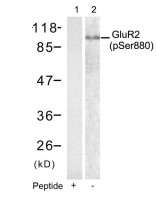ARG51771
anti-GluR2 phospho (Ser880) antibody
anti-GluR2 phospho (Ser880) antibody for Western blot and Human,Mouse,Rat
Neuroscience antibody
Overview
| Product Description | Rabbit Polyclonal antibody recognizes GluR2 phospho (Ser880) |
|---|---|
| Tested Reactivity | Hu, Ms, Rat |
| Tested Application | WB |
| Host | Rabbit |
| Clonality | Polyclonal |
| Isotype | IgG |
| Target Name | GluR2 |
| Antigen Species | Human |
| Immunogen | Peptide sequence around phosphorylation site of serine 880 (I-E-S(p)-V-K) derived from Human GluR2. |
| Conjugation | Un-conjugated |
| Alternate Names | AMPA-selective glutamate receptor 2; GluA2; GluR-K2; Glutamate receptor ionotropic, AMPA 2; GluR-2; HBGR2; GLUR2; GluR-B; Glutamate receptor 2; GLURB |
Application Instructions
| Application Suggestion |
|
||||
|---|---|---|---|---|---|
| Application Note | * The dilutions indicate recommended starting dilutions and the optimal dilutions or concentrations should be determined by the scientist. |
Properties
| Form | Liquid |
|---|---|
| Purification | Antibodies were produced by immunizing rabbits with KLH-conjugated synthetic phosphopeptide. Antibodies were purified by affinity-chromatography using epitope-specific phosphopeptide. In addition, non-phospho specific antibodies were removed by chromatogramphy using non-phosphopeptide. |
| Buffer | PBS (without Mg2+ and Ca2+, pH 7.4), 150mM NaCl, 0.02% Sodium azide and 50% Glycerol. |
| Preservative | 0.02% Sodium azide |
| Stabilizer | 50% Glycerol |
| Concentration | 1 mg/ml |
| Storage Instruction | For continuous use, store undiluted antibody at 2-8°C for up to a week. For long-term storage, aliquot and store at -20°C. Storage in frost free freezers is not recommended. Avoid repeated freeze/thaw cycles. Suggest spin the vial prior to opening. The antibody solution should be gently mixed before use. |
| Note | For laboratory research only, not for drug, diagnostic or other use. |
Bioinformation
| Database Links | |
|---|---|
| Gene Symbol | GRIA2 |
| Gene Full Name | glutamate receptor, ionotropic, AMPA 2 |
| Background | Ionotropic glutamate receptor. L-glutamate acts as an excitatory neurotransmitter at many synapses in the central nervous system. Binding of the excitatory neurotransmitter L-glutamate induces a conformation change, leading to the opening of the cation channel, and thereby converts the chemical signal to an electrical impulse. The receptor then desensitizes rapidly and enters a transient inactive state, characterized by the presence of bound agonist. |
| Function | Receptor for glutamate that functions as ligand-gated ion channel in the central nervous system and plays an important role in excitatory synaptic transmission. L-glutamate acts as an excitatory neurotransmitter at many synapses in the central nervous system. Binding of the excitatory neurotransmitter L-glutamate induces a conformation change, leading to the opening of the cation channel, and thereby converts the chemical signal to an electrical impulse. The receptor then desensitizes rapidly and enters a transient inactive state, characterized by the presence of bound agonist. In the presence of CACNG4 or CACNG7 or CACNG8, shows resensitization which is characterized by a delayed accumulation of current flux upon continued application of glutamate. [UniProt] |
| Research Area | Neuroscience antibody |
| Calculated MW | 99 kDa |
| PTM | Palmitoylated. Depalmitoylated upon glutamate stimulation. Cys-610 palmitoylation leads to Golgi retention and decreased cell surface expression. In contrast, Cys-836 palmitoylation does not affect cell surface expression but regulates stimulation-dependent endocytosis (By similarity). |
Images (1) Click the Picture to Zoom In






